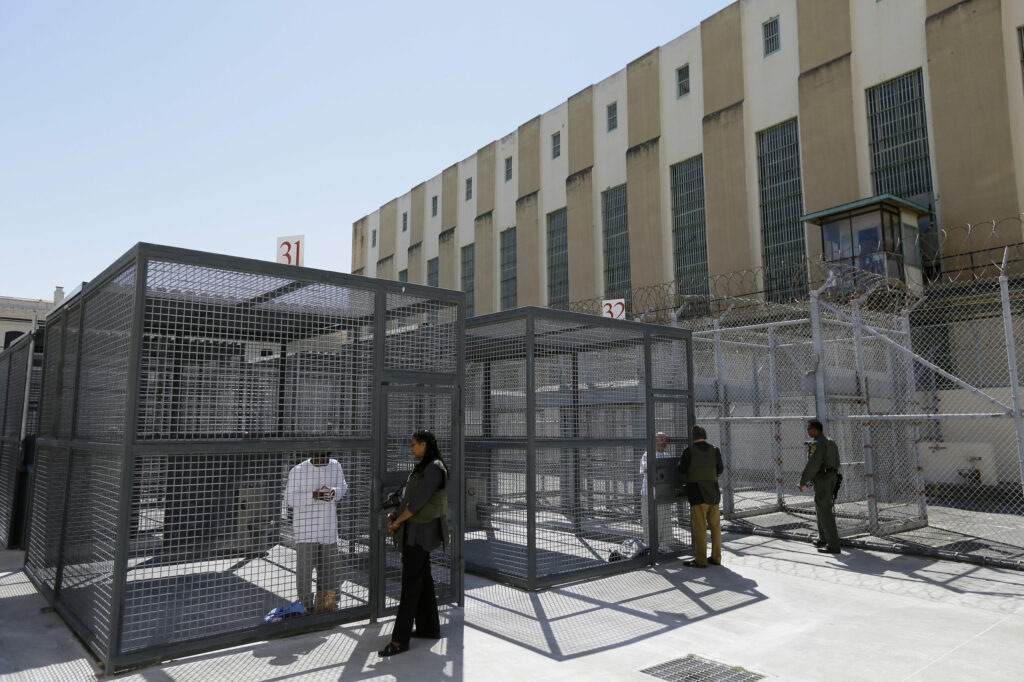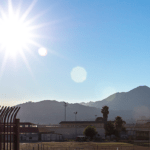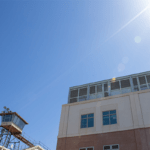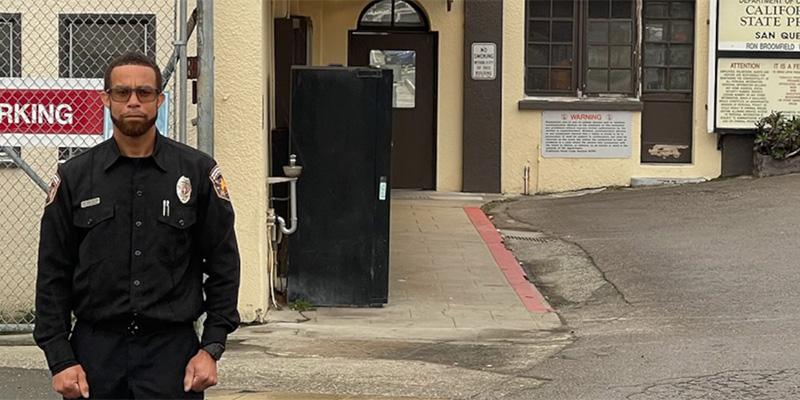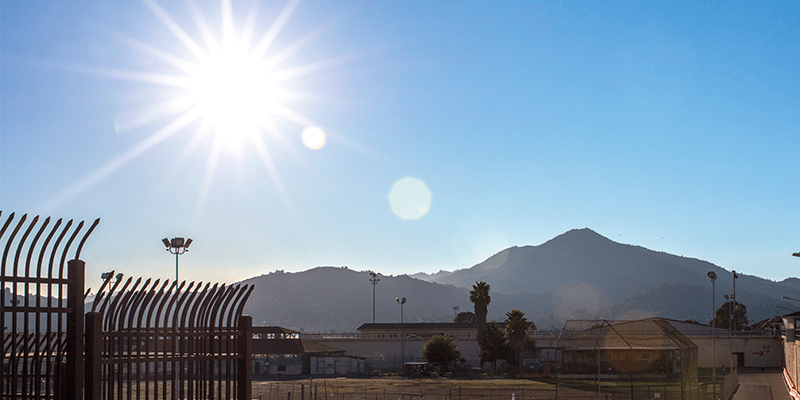This story is part of the Inside/Out Journalism Project by Type Investigations, which works with incarcerated reporters to produce ambitious, feature-length investigations.
Wayne Hughes’s concrete home was windowless and filthy. For more than two weeks, he spent almost 24 hours a day in the six-by-eight-foot cell, which contained a built-in bunk, a grimy sink-toilet combo, and a large fluorescent light. The entire unit, composed of around 100 cells, was locked from the outside; even the correctional officers were locked in and had to be let out at the end of their shifts.
Hughes, who is 66 years old, usually lives in the general population of San Quentin State Prison, a large men’s facility 12 miles north of the Golden Gate Bridge. Typically, those incarcerated there are allowed to walk independently to meals, the yard, programming, and work assignments. But in his new unit, Hughes had to stick his hands through the food slot in the steel door to be handcuffed just to leave his cell for a seven-minute shower. Recreation—on the days it was offered—consisted of four hours alone in a small outdoor recreation cage. Some days, people on the unit are not allowed to leave their cells at all.
The unit has a name: the Adjustment Center. Often shortened to the AC, it has long served as the harshest of California’s death row units, usually used solely for solitary confinement of people whom officials consider a threat to the security of the institution.
But Hughes is not sentenced to death. Nor did staff consider him a risk to the prison’s security—at least not in the traditional sense. Instead, they put him in the Adjustment Center because he had COVID-19.
Since June 2020, San Quentin has used its Adjustment Center as its primary unit for medical quarantine (defined as separating someone who has been exposed to COVID) and medical isolation (separating someone with a confirmed or suspected case). Though the prison was widely criticized and even sued for its mismanagement during the pandemic, San Quentin has continued to send incarcerated people who have been exposed or infected to the notorious unit, including in the spring and summer of 2022, when outbreaks have been relatively less severe.
Type Investigations and The American Prospect spoke to Hughes and more than a dozen other men, many in their sixties and seventies, who told stories of being medically quarantined or isolated in San Quentin’s Adjustment Center throughout the COVID-19 pandemic. These interviews were possible due to Juan Moreno Haines’s unique access as a journalist incarcerated inside San Quentin. The California Department of Corrections and Rehabilitation did not respond to multiple requests for comment on the allegations that arose in these interviews.
Since his first stay in 2020, Hughes said he has been sent back to the Adjustment Center twice: once after a nurse overheard him clearing his throat, and again in spring 2022 after he tested positive for COVID-19.
Hughes and the other incarcerated people interviewed for this story described being trapped in dirty cells in conditions that felt punitive—sometimes while battling serious cases of COVID. They did not set foot outside the Adjustment Center until their quarantine or isolation was over: Even medical care was provided by a nurse inside the unit. And although solitary confinement has been shown to create or exacerbate mental illness, in the AC, people typically only speak with a psychiatrist virtually, by talking through their cell’s food slot, into a laptop held by a staff member on the other side of the door.
When San Quentin first turned the AC into a COVID unit in June 2020, the prison was gripped by a devastating outbreak that infected more than 62 percent of the population and killed 28 incarcerated people and one correctional sergeant over the course of several months. Over a year later, in a class-action lawsuit brought by more than 300 incarcerated plaintiffs (including Haines), Marin County Superior Court Judge Geoffrey Howard found that the California Department of Corrections and Rehabilitation (CDCR) had enabled this devastation by making mistakes and failing to take measures that would have helped stop the spread. (The use of the AC for medical isolation and quarantine came up in the testimony, but was not the focus of the suit.) Ultimately, Judge Howard found the department in violation of the Eighth Amendment banning cruel and unusual punishment. However, citing the safety provided by the 2021 arrival of vaccines in the prison, he did not order the department to make any changes, and denied the petitions as moot.
Although vaccines have helped reduce the risk of severe illness and death both inside and outside prisons, COVID is still everywhere. And while 94 percent of San Quentin’s incarcerated population is vaccinated, Type Investigations and the Prospect found that the prison’s use of the AC for medical quarantine and isolation, as well as the procedures and conditions inside the AC, remain unchanged. People in San Quentin now live under the constant threat of being thrown into one of the state’s most intense and punishing solitary confinement units at a moment’s notice, without doing anything wrong.
In August, California lawmakers passed a landmark bill to curb the use of solitary confinement in jails and prisons in the state. The legislation is awaiting Gov. Gavin Newsom’s signature. Medical isolation and quarantine, however, would still be permitted. There seems to be no end in sight for San Quentin’s use of the AC for medical quarantine and isolation.
Specifically, the solitary reform legislation allows medical isolation for “the shortest amount of time required to reduce the risk of infection, in accordance with state and federal public health guidance and with the written approval of a licensed physician or nurse practitioner.” But the law does not specify how long that should be. In response to a public- records request, CDCR provided us with two documents governing length of stay as of August 2022: one stating that medical isolation must last at least 14 days, and another requiring a minimum of 10 days. Some of those quarantined, however, report spending up to a month quarantining in the AC, especially early in the pandemic.
CDCR told Type and the Prospect it could not comment on pending legislation. When we asked CDCR about its medical isolation and quarantine plans for the future, the department directed us to its “Roadmap to Reopening.” That document outlines that any housing unit with three recent, linked cases must revert to “outbreak phase,” with limited movement among incarcerated people, a ban on family visits, and a halt in any programming that requires outside instructors or counselors. Units that go into outbreak phase may also provide physical and mental health care in-cell and postpone any “routine services.”
The document does not address any policies for the use of medical quarantine or isolation units, or what the conditions in those units should be.
Solitary Confinement as a COVID “Solution”
Many U.S. prisons and jails began relying on solitary confinement in an attempt to curb the spread in the early days of the pandemic, both to limit movement within facilities and to quarantine people who were infected or exposed. This strategy proved to be largely unsuccessful as the virus ravaged the incarcerated population. Many of the worst outbreaks in the country occurred in high-density, often overcrowded correctional facilities, which tend to hold many people with pre-existing conditions, leading to death rates three times higher than in the general population. At the same time, prisons and jails have failed to adequately test or treat people with COVID-19. As the outside world loosens restrictions and the CDC declares COVID-19 is “here to stay,” a new normal of lockdowns and isolation has taken hold inside prisons.
Through a public-records request, Type Investigations and the Prospect obtained monthly bed counts in the Adjustment Center that show the unit’s fluctuations over the past two-and-a-half years, as COVID waves ebb and flow. The number of people in the AC at a given time is often in the high double-digits. When the omicron variant hit California this January, for instance, there were 411 new COVID cases over a two-week period in San Quentin; a point-in-time bed count from the first of that month showed 91 people in the AC, and remained high by the first of February at 84.
William “Mike” Endres, 65, told Type Investigations and the Prospect he had managed to avoid solitary confinement throughout his entire time in prison, until he was sent to the Adjustment Center for 12 days in November 2021. “I’m on my 24th year of disciplinary-free incarceration with no hole time,” he said. “Yet this place found a way to put me in the hole for thinking I have COVID-19 when I didn’t.”
He described the AC as “a disciplinary setting.” Like Hughes, he said he was handcuffed behind his back any time he went to the shower or the yard. His sleep was disturbed by a correctional officer shining a light in his cell every half-hour. Endres said he was never told why he was sent to the AC, and was not given information about when he would be sent back to his normal housing. “I kept asking why I was in the AC, but nobody could tell me why I was there. To this day, I was never given an answer.” Endres says he tested negative four times over his 12 days in the AC, before he was finally transferred out.
Multiple people told us that Adjustment Center staff would come around and hit the doors or shine a light into cells routinely throughout the day and night. Hughes said there was knocking or beeping every 15 to 20 minutes. “It’s hard to get a good night’s sleep,” he recalled. “And you really need to get rest [when you’re sick], but the hitting the door and the beeping goes on all day and all night. It doesn’t stop.” Gregory Jackson, 60, who said he was quarantined in the AC in May 2022, told us that “every half-hour, they’d put something on the door that beeps.” CDCR did not respond to questions about these disturbances, but court records dating back to 2015 suggest they are related to suicide checks, where correctional officers are required to check on the well-being of people in the Adjustment Center every 30 minutes using a system with a hand-held wand and sensor.
Others described dirty cells and showers. Hughes said the sink, toilet, and walls were filthy in each of the cells he was assigned in his three stints in the AC. In one cell, the sink wouldn’t stop running. In another, the sink was covered in soap rings and dried toothpaste, and the toilet was so dirty he didn’t want to use it. When he requested cleaning supplies, he said a correctional officer told him the AC doesn’t have any. Another man, Charles Ross, 60, said he was quarantined in the Adjustment Center in September 2021 and April 2022. “The cells were torn up, they were nasty,” he said. “They wanted me to sign a paper, saying the cells were in good condition, but I didn’t sign it either time. The second time, I had to threaten to 602 them [a term related to filing a grievance application] to get a towel to clean the cell, but they gave me a T-shirt.”
Reporter Juan Haines describes how Wayne Hughes has struggled after contracting COVID in San Quentin.
“You’ll get sick just from being in that filthy place,” Hughes said. “The only thing they do is check your vital signs twice a day. They could have done that in my North Block cell.” Back in his own cell, he said, “at least it’s clean and you have tools to keep it clean. AC is so unsanitary that the medical staff should be ashamed for even accepting that for quarantining people.” CDCR did not respond to questions about why the Adjustment Center was chosen for medical isolation and quarantine. In the 2021 trial, Warden Ron Broomfield testified that it was selected because it is the only unit in the prison (other than parts of the medical facility) with solid cell doors.
We have found that over the course of the pandemic, people have been sent to the AC for testing positive, exhibiting symptoms or having a known exposure to COVID-19, refusing to take a test, being transferred into the prison, or returning to the prison after attending an outside medical or court appointment. But when it comes to preventing COVID, there are alternatives to locking sick and exposed people in solitary confinement. Medical experts have stressed that when incarcerated people are housed alone for medical isolation or quarantine, they should not lose privileges and that the only similarities this experience should share with punitive solitary confinement is being single-celled and separated from the general population. And public-health officials have determined that the only real solution to stopping COVID spread in prisons is widespread vaccination combined with drastically reducing incarcerated populations. As of September 7, San Quentin was filled to 103 percent of its intended capacity.

IMAGE: JANDOS ROTHSTEIN/THE AMERICAN PROSPECT
“Prison Within a Prison”
The Adjustment Center was built in 1960, a relatively late addition to the fortress-like San Quentin, which was built in 1852. For years, it has held people on death row, along with a smaller number of non-condemned people sent to solitary confinement. It is infamous among the incarcerated, often referred to as a “prison within a prison.” In 2015, six men on death row brought a class action lawsuit, arguing the unit was so restrictive that it amounted to cruel and unusual punishment. In a settlement, CDCR agreed to cap stays in the AC (which had once been indefinite) at five years.
“The hollow steel cell doors have two slivered windows that look out onto a bleak hallway and a small locked slot that is used to deliver food to plaintiffs and to handcuff them before they are transported from their cell,” the 2015 complaint detailed. “The cells have no windows to the outside. Plaintiffs have no natural light or airflow in their cells.”
People who have been medically isolated or quarantined in the AC during the COVID-19 pandemic say the unit still matches the physical descriptions from the 2015 lawsuit.
After the 2015 lawsuit ended indeterminate stays in the AC, the unit’s population decreased. At the beginning of March 2020, there were only 30 people in the unit, according to bed counts provided by CDCR.
That changed when COVID-19 hit. In late May 2020, CDCR responded to an outbreak at another facility, the California Institution for Men (CIM), by transferring 122 medically vulnerable people by bus into San Quentin. About a week later, when it became clear some of the new transfers already had COVID, San Quentin officials sent much of the group to quarantine in the Adjustment Center. But COVID was already spreading, and by June 16, there were 90 people quarantining in the AC. As the AC filled up, officials relocated the remaining death row occupants out of the unit. The AC population has spiked back into the 90s at least twice since then, in November and December 2020, and again in January 2022. Terry Kitchen, 35, said he was sent to the AC for ten days in June 2022, after a rapid COVID test he was required to take to receive dental work came back positive. Although a staff member asked if he wanted anything from his old cell, he said nothing he requested—ten ramen packets, self-help program materials, college work, and hygiene products—was brought over.
He said the cell and showers were dirty, and the cell was bare except for a radio that didn’t work. “When I was over there I was so isolated,” Kitchen told Type Investigations and the Prospect. “There’s a little window [in the cell door] where all you can see is a wall. So your entertainment is watching spiders and ants walk around.” There was always a humming sound in the background, and he could hear someone yelling frequently.
He said medical and correctional staff would not answer his questions. “You don’t know anything about when you’re getting out of AC,” he said. “That in itself is stressful.”
The phones in the AC area weren’t working, according to Kitchen, and he said the staff did not give out prepaid indigent envelopes, which poor people can use to send letters. “I was isolated where I could not contact my family and let them know what was going on with me,” he said. “I couldn’t even write a letter, because I was not offered anything to communicate with my family. It was miserable, which traumatized me. Which is why I’m not going back to dental, until I don’t have to take a rapid test to be seen.”
‘You’ll get sick just from being in that filthy place.’
WAYNE HUGHES
The isolating nature of the Adjustment Center makes mental health care even more crucial—and even harder to access—than it already is in prison. Dr. Paul Burton testified as chief psychiatrist at San Quentin in the 2021 class action lawsuit that mental health interactions in the AC are conducted through the door’s food slot, through which he insisted, “you can actually hear pretty well.” Typically, he said, a nurse stands outside the cell door with a laptop, meaning the patient must communicate with his doctor through both a solid door and a computer. When telehealth appointments are conducted at the cell door in other units of the prison, the patient is offered headphones, so at least the doctor’s side of the conversation is confidential. But in the Adjustment Center, he explained, headphones won’t fit through the door slot, so the entire conversation is audible to passing officers and others incarcerated on the tier.
“It’s not confidential,” Dr. Terry Kupers, a psychiatrist who studies the psychological effects of solitary confinement, told Type Investigations and the Prospect. “You can be victimized because you’re mentally ill. What kind of situation is that, for a prisoner to have their only access to mental health treatment … in public, essentially, no privacy?”
“Horrendous Psychological Stress”
Solitary confinement is proven to cause mental deterioration, leading to higher rates of self-harm and suicide. The United Nations considers solitary to be torture when used for more than 15 days. But even shorter stays can be detrimental. Even after release from prison, people who spent any time at all in solitary are more likely to die prematurely than formerly incarcerated people who did not experience solitary, especially from suicide.
The practice “puts horrendous psychological stress on people,” said Kupers. No matter the length of the stint, he said, “each time you’re in a solitary confinement cell with no window and a solid door, and you go to a little cage to exercise, that’s no small thing.”
Instead of being locked alone in restricted cells, “those in medical isolation may be housed together with others who also have COVID-19,” suggests a paper lead-authored by David Cloud, research director at Amend, a program within the University of California, San Francisco, that focuses on the intersection of criminal justice and public health. The CDC similarly suggests that groups of positive people can be cohorted together in a “single, large, well-ventilated room with solid walls and a solid door that closes fully.” The CDC notes that this can conserve resources, and “mitigate some mental health concerns associated with individual medical isolation.” CDCR did not respond to questions about whether they considered this guidance.
And while the CDC recommends that people with a suspected case or known exposure should ideally be housed alone, Cloud notes that people held for medical reasons should be in sanitary, ventilated spaces and should have enhanced access to “resources that can make their separation psychologically bearable,” such as TV, radio, reading materials, tablets, phone calls, and outdoor exercise. He writes: “They should have easy access to medical and mental health professionals, and daily updates from healthcare staff as to why separation is necessary and how long they can expect it to last.”
Instead, fear of the harsh conditions awaiting them in the AC can make people less likely to alert medical staff when they are feeling sick, contributing to uncontrolled spread.
And being sick in the AC can be terrifying. Larry Williams, 47, was sent to the Adjustment Center after testing positive for COVID in June 2020, during the worst of San Quentin’s outbreak. “I went in the cell, they closed the door,” he told Type Investigations and the Prospect. “And then that’s when hell began.” Battling a serious case of COVID, Williams’s chest started hurting and he had trouble breathing. Next came excruciating headaches and an uncontrollable cough. He deteriorated from roughly 240 to 194 pounds.
Williams said his blood pressure dropped lower and lower, until a nurse knocked on the cell door late one night, telling him to stop taking his prescribed blood pressure medication immediately or he might have a heart attack.
Sleep was hard, he said, because he was terrified he wouldn’t wake up. He was surrounded by sickness and death. He recalled seeing bodies being carried out of nearby cells.
“It just made me afraid of my mortality,” he said. “And it made me start thinking deeper than I’ve ever thought.”
Reporter Juan Haines recounts William “Mike” Endres’s time in the Adjustment Center.
Contrary to recommendations from groups like Amend, people repeatedly told us that conditions in the Adjustment Center made them feel like they were being punished, not treated for a serious illness. The official unit guidelines back up their claims. “All inmates will be treated according to the highest level of custody on your tier (Condemned, Ad-Seg, etc.),” outlines a set of “the AC Guidelines” handed out by prison staff to people sent there for medical isolation or quarantine, and obtained by Type Investigations and the Prospect. “You will be handcuffed and escorted by staff during any movement within the unit.” The document lists other rules: two toilet flushes per hour, 30 minutes of phone access per day, and seven minutes per shower (“Use your time wisely.”).
Osbun Walton, 73, said he was quarantined in the AC in April 2022, after returning to the prison from an outside resentencing hearing. He told Type Investigations and the Prospect that he was handcuffed just to go to the showers 15 feet from his cell, as well as to get an EKG on the unit, about 30 feet down the tier. “It was like we were there because we messed up.”
California Has Failed to Depopulate Its Prisons
Solid prison cell doors, like the ones in the AC, have failed to stop COVID-19: An analysis of COVID data from California prisons throughout 2020 showed the virus can, in fact, spread through units with solid-walled cells. An analysis published in June 2022 of San Quentin’s COVID outbreak found that the prison’s air filtration systems further contributed to the spread. Meanwhile, other CDCR policies appear to undermine San Quentin’s quarantine requirements. For example, due to contract stipulations with the prison labor union, the prison has not “cohorted” its staff during the pandemic, meaning that people can work some shifts in the AC and other shifts elsewhere in the prison, bringing the virus back and forth with them.
Throughout the pandemic, Kupers and other experts have said that prisons and jails must depopulate to save lives. A 2021 paper in the New England Journal of Medicine found that a 9 percent reduction in the population of a large urban jail led to a 56 percent decrease in transmission—and additional population decreases led to further transmission reductions. A 2021 paper in the Journal of Urban Health analyzed decarceration and transmission rates in Texas prisons, reaching similar conclusions.
Back in June 2020, CDCR was warned by Amend in an “urgent memo” to reduce San Quentin’s population by 50 percent from its then-population of 3,547. Three months later, a California state appeals court ordered CDCR to follow through on the recommendation. But while CDCR did manage to reduce San Quentin’s population by 33 percent, to 2,384 in May 2021, the population has since shot back up. Its population was 3,183 as of September 7, 2022, just about 10 percent lower than the 2020 number, and still over 100 percent of the capacity the facility is designed to hold. Absent a major population reduction, many people throughout the prison continue to be double-celled in tiny 11-by-4.5-foot cells—a worst-case scenario for limiting the spread of disease.
‘It just made me afraid of my mortality. And it made me start thinking deeper than I’ve ever thought.’
LARRY WILLIAMS
CDCR did not respond to questions about whether it has any plans to reduce the San Quentin population. In the 2021 class action trial, Warden Broomfield testified that he and other officials had not considered Amend’s recommendation, and stated, “I do not recall having conversations to reduce the population to 50 percent.” Pushed on whether there is a plan to depopulate San Quentin in the case of further outbreaks, the warden testified, “I am unaware of future plans to reduce San Quentin’s population.”
Instead of decarceration, the warden testified that any plans to prevent future outbreak revolve around the use of the AC: “We quarantine as many inmates as we can in the Adjustment Center to this day.”
Wayne Hughes is still struggling with the lingering effects of COVID. The infections left him with serious new ailments, including heart problems and blood clots in his lungs.
“Nothing was wrong with me before I caught COVID,” he told Type Investigations and the Prospect. Now, “each time I try to exert myself I get short of breath. I have to use three different inhalers on a daily basis.” He was put on blood thinners, which has made it unsafe to get a needed hernia operation. “My general health is poor. My emotions are sad because I don’t feel the medical staff is doing much of anything for me.”
Before contracting COVID, Hughes worked in the kitchen and filled his days with self-help classes that focused on anger management, domestic violence, substance abuse, and social skills. “I took a lot of groups because I’m trying to better myself for my future,” he explained. “I don’t want to repeat the same mistakes that got me in here.” But now, he said, programming is limited. “Things don’t seem to be getting better.”
“I’m so frustrated to almost being angry that they put me back there, again,” said Hughes of his most recent stint in the AC. “If AC is supposed to be for quarantine, why are they treating us like we’re being punished for getting COVID? The guards’ overall attitude is like we’ve done something wrong.” This fall, he has a tentative date for a parole hearing. Until then, he hopes he can avoid a fourth stay in the AC.
Katie Rose Quandt
Katie Rose Quandt is a freelance journalist based in the Bronx, who often writes about criminal justice and inequality. Follow her on twitter @katierosequandt.
Juan Moreno Haines
Juan Moreno Haines is senior editor of the San Quentin News and a contributing writer at Solitary Watch.
Attribution: This article was first printed in typeinvestigations on September 19, 2022 (The caged exercise yard of the Adjustment Center on death row at San Quentin State Prison on Aug. 16, 2016. IMAGE: ERIC RISBERG/AP PHOTO)
